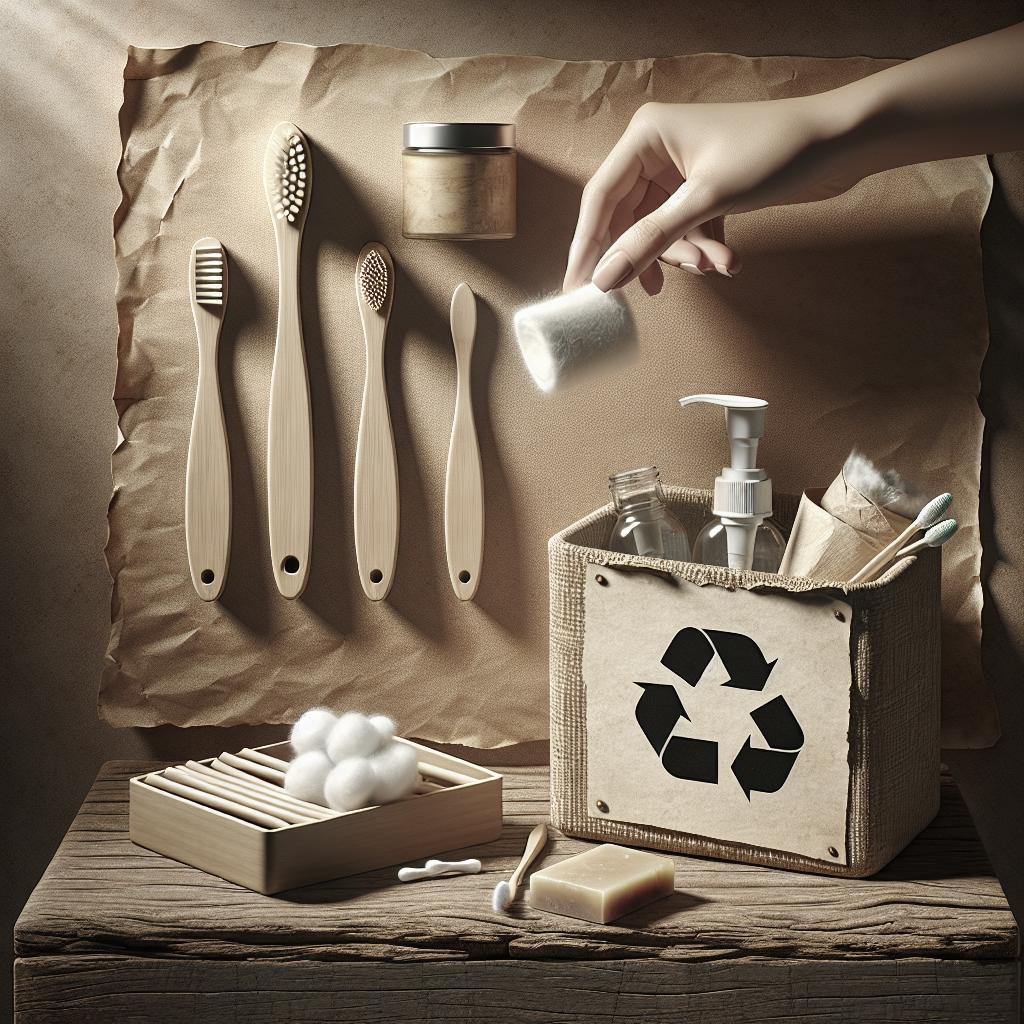In today’s fast-paced world of beauty and skincare, an ever-growing concern looms: plastic waste. From lavish packaging to single-use wipes, the skincare industry contributes significantly to environmental degradation. Reducing skincare waste isn’t just about eco-conscious choices; it’s about rethinking our entire approach to beauty and sustainability. In this blog post, we delve into the magnitude of the plastic problem within the beauty industry, highlight the severe environmental harm it causes, and present actionable solutions. Learn how to purchase only what you need, recycle effectively, make sustainable swaps, and choose refillable beauty products. Discover how you can seamlessly incorporate sustainable products into your routine without sacrificing quality or innovation. Together, let’s embrace a more sustainable beauty routine that aligns with our personal wellness goals and the well-being of the planet. How Big Is the Plastic Problem in the Beauty Industry? The beauty industry is renowned not only for its innovation and creativity but unfortunately, also for its significant contribution to global plastic waste. Every year, millions of tons of plastic packaging are produced, with a huge proportion ending up in landfills or the ocean. Most beauty products are housed in plastic containers, tubes, and wraps, often combined with non-recyclable materials that complicate eco-friendly disposal. According to recent statistics, the beauty sector generates an estimated 120 billion units of packaging globally every year. This staggering figure illustrates the magnitude of the problem, with overflow seen in every corner of our planet, from urban cities to remote wilderness. The majority of these plastic containers will take hundreds of years to decompose, leaving an enduring mark on the earth’s landscape. The allure of aesthetically pleasing and travel-friendly packaging contributes to this crisis. As consumers, we are driven by marketing and design, often disregarding the environmental cost. This culture of convenience and disposable beauty needs a drastic shift if we aim to reduce our footprint and nurture a healthier relationship with skincare. What’s the Harm From All This Plastic Waste? Plastic waste from the beauty industry doesn’t just clutter our landfills; it poses a severe threat to marine ecosystems and wildlife. As these plastics break down into microplastics, they infiltrate water supplies and food chains, causing harm to aquatic life and potentially impacting human health. These tiny particles are ingested by marine animals, leading to detrimental health effects and often death, which disrupts the entire ecosystem. The environmental hazards extend beyond wildlife. As plastics degrade, they release harmful chemicals into the air and soil, contributing to pollution and global warming. This not only affects plant growth and agricultural productivity but also exacerbates climate change challenges. The cumulative effect is a vicious cycle where degraded ecosystems can no longer operate efficiently, impacting biodiversity and ultimately, human survival. The beauty industry’s heavy reliance on plastic packaging is a significant contributor to these environmental issues. The persistent use of non-biodegradable materials stresses the urgent need for a sustainable overhaul. By understanding the long-term harm and acknowledging our role in it, we can begin to take meaningful actions toward change. Buy Only What You’ll ACTUALLY Use An effective start in reducing skincare waste is adopting mindful consumption habits. The beauty industry’s marketing prowess can often persuade us into purchasing more than our actual needs, leading to cluttered vanities and wasted products. It’s crucial to critically assess what products serve genuine needs versus those bought due to hype. Creating an inventory of existing beauty products can help in identifying what items are truly necessary. This also prevents the duplication of similar products that ultimately contribute to waste. Conscious shopping not only minimizes waste but also saves money and ensures that products don’t sit unused, expiring before they can be utilized. One strategy is to prioritize multi-purpose products, which reduce the number of separate items needed in your beauty routine. For example, a moisturizer with SPF can minimize separate purchases of sunscreen and lotion. By opting for versatile, high-quality products, you can simplify your routine and reduce your environmental impact. Recycle the Right Way Recycling plays a pivotal role in managing and reducing skincare waste. Despite good intentions, many people recycle incorrectly, leading to contaminated recycling streams. Understanding the specific recycling guidelines for beauty products is critical, as not all plastics are treated equally in the recycling process. Effective recycling starts with proper sorting. Separate lids, pumps, and any mixed-materials packaging, since these are often made from different types of plastics that must be processed differently. Rinse containers to remove product residue, as contaminants can impede the recycling process. Familiarize yourself with local recycling regulations to determine what can and cannot be recycled in your area. Moreover, participating in specialized recycling programs offered by beauty brands can also ensure better outcomes. Many companies now offer take-back schemes where you can return empty containers in exchange for rewards. These programs facilitate a circular economy within the beauty industry by recycling components into new products. Make Sustainable Swaps for Daily-Use Disposables Reducing disposable waste is a straightforward approach to diminishing our skincare-related environmental footprint. Single-use items like cotton swabs, makeup remover wipes, and sheet masks contribute significantly to daily waste. By making sustainable swaps, you can maintain your beauty regime while supporting ecological balance. Reusable alternatives abound, with options like washable cotton pads or microfiber cloths that cleanse the face without accumulating single-use clutter. These alternatives are not only cost-effective in the long run, but they also greatly reduce daily waste. Additionally, consider leveraging natural materials like bamboo applicators to replace plastic ones. Eco-friendly brands increasingly offer biodegradable or compostable substitutes for everyday disposables—such as wipes made from plant fibers. These brands are committed to environmental stewardship, often providing products in minimalistic or recyclable packaging. By switching to such sustainable alternatives, you support businesses driving positive change. Choose Refillable Beauty Products Refillable products represent a sustainable leap forward in reducing skincare waste. Many beauty brands are now launching products with the intention of reusing the primary packaging, allowing consumers to replenish their favorite products without additional waste. The refillable model emphasizes both environmental and economic advantages. Consistently purchasing refills generally costs less than buying entirely new products, supporting both sustainability and savvy spending. Brands that offer refill options often commit to reducing their carbon footprints, aligning with conscientious consumer values. Adopting refill practices requires a shift in consumer mindset toward patience and planning. You may need to order refills in advance to avoid running out and shifting back to non-refillable options. However, the reward is a more sustainable beauty routine that benefits both the planet and your pocket. Incorporating Sustainable Products Into Your Beauty Routine Incorporating sustainable skincare products into your routine isn’t just about reducing waste; it’s also about supporting a global movement toward environmentally conscious living. Start by researching brands that prioritize sustainability, offering organic formulations and eco-friendly packaging. Understand the product lifecycle, including sourcing, production, and post-consumer processes, to ensure holistic sustainability. Look for certifications like Organic, Fair Trade, or Leaping Bunny, which signify commitment to ethical and sustainable practices. These labels act as a guide to making informed choices that align with your values. Educate yourself and others on the benefits of sustainable skincare routines. Emphasize the importance of small, consistent changes that cumulatively make a significant impact. Share your journey with friends and family to inspire collective efforts toward more sustainable beauty practices. The impact will be felt both personally and globally, as together we drive meaningful change. Lessons Learned Here’s a concise summary of action points to reduce skincare waste: “`html
| Actionable Step | Description |
|---|---|
| Understand the Plastic Problem | Recognize the extent of the issue generated by the beauty industry and its environmental impact. |
| Mindful Consumption | Evaluate actual needs before purchasing and consider multi-purpose products to reduce waste. |
| Effective Recycling | Learn to recycle beauty products properly and participate in industry take-back initiatives. |
| Sustainable Swaps | Replace single-use disposables with reusable or biodegradable options to cut daily waste. |
| Refillable Options | Choose refillable products to minimize packaging waste and support a circular economy. |
| Incorporate Sustainable Brands | Align with brands committed to sustainable practices, ensuring ethical product lifecycles. |
“` Through these steps, you’re not just reducing skincare waste, but also contributing to a broader shift toward sustainable living. Opting for eco-friendly practices within your beauty routine is a powerful way to cultivate environmental stewardship and positive change.


